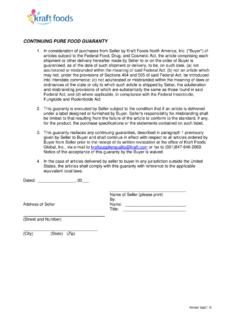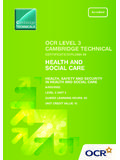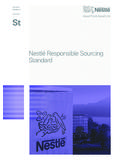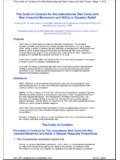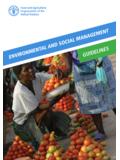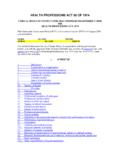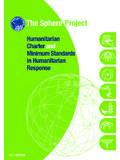Transcription of SUPPLIER AND EXTERNAL MANUFACTURER
1 Issue Date: 10-May -10 SUPPLIER and EXTERNAL MANUFACTURER HACCP Manual Supersedes: 12-Feb-08 SUPPLIER AND EXTERNAL MANUFACTURER HACCP MANUAL Issued by: Approved by: Reviewed by: Name: Viviane Bronstein Matilda Freund Loralyn Ledenbach Function: Global Procurement Quality Global Food Safety Global Food Safety Issue Date: 10-May-10 SUPPLIER and EXTERNAL MANUFACTURER HACCP Manual Supersedes: 12-Feb-08 INTRODUCTION Page 2 of 98 TABLE OF CONTENTS INTRODUCTION 4 1. PREREQUISITE PROGRAMS 6 2. HAZARD ANALYSIS AND RISK ASSESSMENT 8 3. STANDARD FOR HAZARDS THAT MAY BE MANAGED BY CCP 12 4. HACCP PLAN DOCUMENTATION COMPONENTS 19 5. HACCP SYSTEM VERIFICATION/VALIDATION PROCEDURES 22 6. PACKAGING SUPPLIERS 25 Appendix A: HACCP Plan Review Checklist 28 Appendix B: Kraft Foods Biologically Sensitive Ingredient Category List 32 Appendix C: Kraft Foods Food Allergen Category List 34 Appendix D: HACCP Plan Documentation Forms and Examples 38 Appendix E.
2 Model Critical Control Points and Prerequisite Programs 59 Model CCP: PASTEURIZATION HTST / HHST 59 Model CCP: PASTEURIZATION Batch 62 Model CCP: PRODUCT COOK 64 Model CCP: PRODUCT COOK NON-FAT BASED PRODCUTS 67 Model CCP: HIGH MOISTURE MATERIAL HOLDING TIME/TEMPERATURE PRIOR TO HEAT STEP 69 Model CCP: PRODUCT BAKE 73 Model CCP: REWORK HANDLING 75 Model CCP: EQUIPMENT CLEANING FOR ALLERGEN REMOVAL (PRODUCT CHANGEOVER) 77 Model CCP: PRODUCT FLUSHING FOR ALLERGEN REMOVAL (PRODUCT CHANGEOVER) 79 Model CCP: EXTRANEOUS MATERIAL DETECTION 81 Model CCP: FILTRATION IN-LINE 84 Model CCP: MAGNET 86 Model PP.
3 SENSITIVE INGREDIENT POST-LETHAL PROCESS ADDITION 88 Model PP: GLASS BREAKAGE - PACKAGING 89 Issue Date: 10-May-10 SUPPLIER and EXTERNAL MANUFACTURER HACCP Manual Supersedes: 12-Feb-08 INTRODUCTION Page 3 of 98 Appendix F: Packaging Model Critical Control Points (PCCP) and Prerequisite Programs (PP) 90 Model CCP: GLASS MANUFACTURING. FOREING MATERIAL OR DEFECT DETECTION DEVICE 90 Model CCP: AUTOMATED LABEL VERIFICATION ALLERGEN CONTROL 92 Model CCP: PRINTED PACKAGING MATERIAL AND LABELS LINE CHANGEOVER 94 Model CCP: PRINT COPY VERIFICATION 96 Model PP: CUT AND STACK LABELS 97 Model PP: FOOD CAN SEAM INTEGRITY 98 Issue Date: 10-May-10 SUPPLIER and EXTERNAL MANUFACTURER HACCP Manual Supersedes.
4 12-Feb-08 INTRODUCTION Page 4 of 98 INTRODUCTION Kraft Foods SUPPLIER Quality Expectations Manual requires Suppliers to have a documented Hazard Analysis Critical Control Point (HACCP) plan in place for all products, ingredients, and packaging materials (product-contact, labels, and labeled packaging materials) manufactured for Kraft Foods. The HACCP system is a preventative approach to managing food safety. Philosophically, HACCP moves away from end point testing to a more proactive, preventative approach to control potential hazards. While HACCP cannot guarantee that food safety issues will not arise, it does provide a mechanism to reduce risk. When utilizing HACCP, hazards are identified, associated risks are assessed, methods for control are identified, critical control points (CCPs) are specified, and criteria for compliance are clearly defined. The Kraft Foods SUPPLIER and EXTERNAL MANUFACTURER HACCP Manual was developed to communicate Kraft Foods requirements for HACCP plan development and implementation.
5 This document is meant to be used by an expert, cross-functional team formed to develop a HACCP plan and is not a substitute for the team approach. For Kraft Foods developed formulas, Kraft product developers shall provide a partial HACCP plan including the Hazard Analysis to the SUPPLIER / EXTERNAL MANUFACTURER (EM). This information is to be used by the SUPPLIER and by the EM for their HACCP Plan. For products developed by Suppliers/EM, the SUPPLIER /EM shall develop HACCP plans consistent with this guide. This HACCP Guide contains the following sections: 1. Prerequisite Programs (PP). HACCP is not a stand alone program but is part of a larger control program. Prerequisite Programs are defined as the universal procedures used to control the conditions in the plant environment which contribute to the overall safety of the product. Kraft Foods considers documented Prerequisite Programs as the foundation of food safety management.
6 Prerequisite Programs must be developed, implemented, and documented before attempting to put a HACCP plan in place. 2. Hazard Analysis and Risk Assessment. This is an initial step in the development of a HACCP plan. The preliminary steps to HACCP development include: 1) assemble the HACCP team, 2) describe the food and its distribution, 3) identify the intended use and consumers 4) construct a process flow diagram, 5) conduct an on-site verification of the flow diagram, and 6) conduct a hazard analysis. During the hazard analysis, the team should determine all potential biological, physical, and chemical hazards that can exist in the raw materials and during the manufacturing stages of the product. Once the hazards are identified, they are assessed for severity and likelihood of occurrence using the Hazard Evaluation Flow Chart . The chart is designed to guide the team through the evaluation to determine if the hazard identified needs to be controlled by the HACCP system or by a Prerequisite Program.
7 Once the hazards to be controlled within the HACCP system have been identified, the Critical Control Points (CCPs) to control the hazards must be determined. The team shall use the Codex Decision Tree for CCP Determination and the guidance provided in Section 2 for the determination of the point(s) in the process that should be managed as the CCP(s). Issue Date: 10-May-10 SUPPLIER and EXTERNAL MANUFACTURER HACCP Manual Supersedes: 12-Feb-08 INTRODUCTION Page 5 of 98 3. Standard for Hazards Which May be Managed by CCP. This section provides guidance to the team as to the type of hazards that can and should be addressed in a HACCP plan. It also provides some general rules as to which hazards shall be managed by CCPs. Appendix B: Kraft Foods Biologically Sensitive Ingredient Category List Appendix C: Kraft Foods Food Allergen Category List 4. HACCP Plan Documentation Components, the required documentation for the HACCP plan is described.
8 Forms for documentation and examples are provided in Appendix D. The content of the forms is required; however, the format of the forms is optional. Appendix D: HACCP Plan Documentation Forms and Examples Appendix E: Model Critical Control Points and Prerequisite Programs 5. HACCP System Verification/Validation Procedures. This section describes the verification process for determining that the HACCP plan is accurate. Appendix A: HACCP Review Checklist 6. Packaging Suppliers. Suppliers of packaging material (product-contact, labels, and labeled packaging materials) manufactured for Kraft Foods shall develop HACCP plans consistent with this standard. Additionally, more specific guidelines for Packaging SUPPLIER are outlined on this chapter. Appendix F: Packaging Model Critical Control Points and Prerequisite Programs For any questions on the content contained within this document contact your Kraft Foods contracting Date: 10-May-10 SUPPLIER and EXTERNAL MANUFACTURER HACCP Manual Supersedes: 12-Feb-08 PREREQUISITE PROGRAMS Page 6 of 98 1.
9 PRE-REQUISITE PROGRAMS Prerequisite Programs are defined as the universal procedures used to control the conditions in the plant environment, which contribute to the overall safety of the product. Kraft Foods considers documented Prerequisite Programs as the foundation of food safety management. CCPs are not a stand-alone control but are part of a safety plan consisting of PPs and CCPs. Prerequisite Programs must be developed, implemented, and documented before attempting to put a HACCP plan in place. Effective implementation of HACCP relies on adherence to Prerequisite Programs. If any portion of a Prerequisite Program is not adequately controlled, then additional CCPs may have to be managed until Prerequisite Programs are adequate. The following is a list of Prerequisite Programs that typically apply to manufacturing facilities. The exact set of Prerequisite Programs needed will vary since their application is product and process specific, just like a HACCP plan.
10 Therefore, the following list is meant to be informational. That is, it may include programs which are not needed in some situations and may not include programs which are needed in other situations. Occasionally, one of the Prerequisite Programs may be managed as a CCP ( , meat chilling for uncured ready-to-eat poultry). In some cases, a Prerequisite Program may be mandated by a regulatory agency. Premises a) Building Structure and Utility Systems b) Outside Property c) Water Quality Program (Treatment and Testing) d) Building/Grounds Security Personnel Training Program a) Employee Hygiene/Employee Practices b) HACCP/CCP specific training Health and Safety Recalls a) Hold and Release b) Recall Procedures c) Traceability/Code Dating Receiving/Storage a) Raw Material Management b) Receiving/Storage/Distribution c) Certificate of Analysis (COA) d) Letters of Guarantee e) Hold and Release f) Truck/Carrier Inspection g) Label review for accuracy ( Keep Refrigerated , Cooking Instructions, Ingredient List-Allergen) Equipment Performance and Maintenance a) Preventative Maintenance b) Equipment Calibration c) Compressed Air Filtration d) Equipment Design Issue Date.

